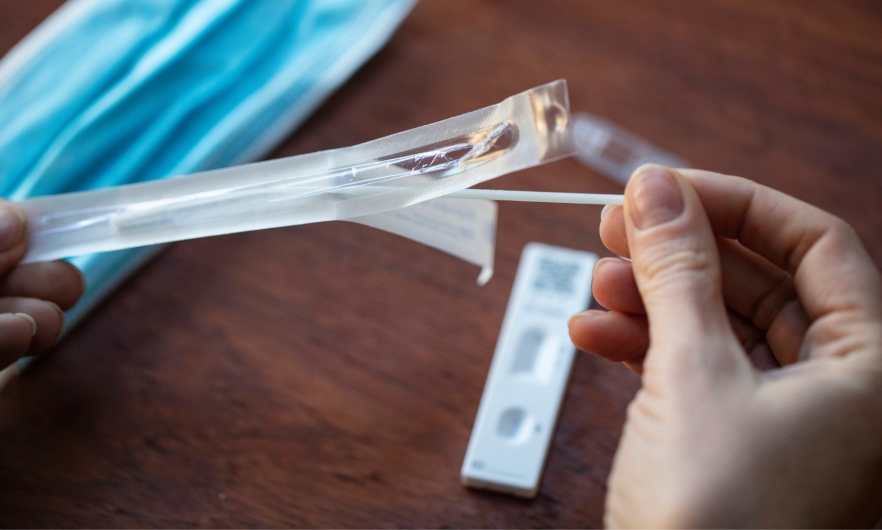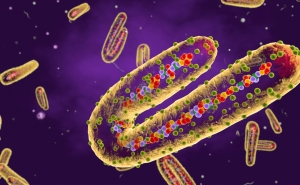What to Know About COVID FLiRT Variants
Virologists are keeping an eye on several COVID variants that have all picked up the same set of mutations. Here’s what that means.

At the end of March, the KP.2 variant was causing about 4% of infections in the U.S., according to the CDC, while its parental strain, JN.1, was causing over 50% of infections at that time. As of early May, KP.2 makes up about 28% of infections, overtaking JN.1 as the dominant variant.
KP.2 is one of several variants being referred to as “FLiRT variants,” named after the technical names for their mutations. The prevalence of these variants comes at a critical time, when experts are deciding how to formulate the fall COVID vaccine.
In this Q&A, Andy Pekosz, PhD, a professor in Molecular Microbiology and Immunology, explains what virologists like him are seeing, whether these variants might cause a summer wave of infections, and how people can protect themselves.
What are these “FLiRT variants”?
This is the term being used to describe a whole family of different variants—including KP.2, JN.1.7, and any other variants starting with KP or JN—that appear to have independently picked up the same set of mutations. This is called convergent evolution. They are all descendants of the JN.1 variant that has been dominant in the U.S. for the past several months.
The particular mutations that people refer to as “FLiRT”s or “FLip”s refer to specific positions in the spike protein—in this case, positions 456, 346, and 572.
Viruses like SARS-CoV-2 mutate frequently, and when they mutate to evade recognition by antibodies, this often weakens their ability to bind to the cells they want to infect. We then see mutations appear that improve that binding ability. This is a cycle we have seen many times with SARS-CoV-2. The fact that these different variants are picking up the same mutations tells virologists that this combination of mutations is helping the virus accomplish these goals most efficiently.
How do these mutations help the virus bind to cells while evading antibodies?
Two of these mutations—456 and 346—eliminate binding sites for antibodies that neutralize SARS-CoV-2. However, those same antibody binding sites are also important for the virus to bind to and enter cells. So in evading antibodies, these FLiRT variants may have also lost some ability to bind to their receptor. At the same time, the 572 mutation appears to allow the virus to more tightly bind to cells and ultimately cause an infection.
Do people who recently had COVID have any protection against infection from FLiRT variants?
A JN.1 infection should provide pretty strong protection against all the FLiRT variants. The difference between JN.1 and these variants is only one or two amino acid changes, so there are still a lot of other places antibodies can bind to. Infection from a variant older than JN.1 is less likely to offer as much protection.
Do we know yet how well the current COVID-19 vaccines work against the FLiRT variants?
Against JN.1, the vaccine designed around XBB.1.5 does generate some cross-reactive antibodies. Studies have not been yet done with some of these newer variants, but those are likely to be a little less cross-reactive. It’s also been several months since many people received their last dose of the vaccine, and that immunity wanes over time.
Back in February, the CDC recommended an additional dose of the current COVID vaccine for adults 65 and older who received theirs in the fall. There is a question now of what the guidance will be going into the summer. We’ve seen fairly low uptake of these additional boosters when they’re recommended, even in high risk populations, so it’s unclear whether a third dose of the current vaccine will be recommended. If case numbers remain relatively low, it may not be necessary.
Should we anticipate these variants to drive a surge in cases this summer?
It’s certainly possible. The FLiRT variants would be high on my list of viruses that could cause another wave of infections in the U.S. That said, our definition of a wave has changed; while we still see case rates rise and fall throughout the year, we see much lower numbers of cases of hospitalizations or deaths than we saw in the first couple years of the pandemic.
And yet, while these waves are becoming smaller, they are still having the greatest impact on our susceptible populations: the elderly, people who are immunocompromised and those with other secondary medical conditions. Everyone can play a role in protecting those populations that remain the highest-risk when new variants cause an uptick in cases.
How might these variants impact plans for the COVID vaccine formula that gets updated for the fall?
This is the time of year when governing bodies like the WHO and FDA recommend a formulation for updated COVID vaccines that will roll out in early fall. Last year, the vaccines were based on the XBB.1.5 variant, and only a few months later, the JN.1 variant became the dominant variant in the U.S.
At the end of April, the WHO announced that their COVID vaccine advisory group advises using the JN.1 lineage as the antigen for the upcoming formulations of the vaccine. All of these FLiRT variants are within the JN.1 family of variants.
Here in the U.S., the FDA has postponed its meeting to determine the fall 2024 COVID vaccine from mid-May to early June. That gives them more time to see which of the FLiRT variants is becoming the dominant one so they can fine-tune the WHO recommendation to what they anticipate will be most prominent in the fall.
New COVID variants are likely to crop up after a decision is made—just as it did last summer—but the goal remains to select a formulation that, come fall, will match the circulating variants as closely as possible.
Editor’s note: In June 2024, the FDA’s Vaccines and Related Biological Products Advisory Committee advised that COVID-19 vaccines for use in the U.S. beginning in fall 2024 should be monovalent JN.1-lineage vaccines, with a preference for the KP.2 strain if feasible.
What are the usual symptoms and transmission timeline for FLiRT variants?
When it comes to symptoms, we’re not seeing anything new or different with these variants. We continue to see more mild disease, but that’s likely not because the virus is milder, but because our immunity is so much stronger now. After years of vaccinations and infections, most of the population is better able to fight off an infection without as much concern for severe disease.
The period of infectiousness for these FLiRT variants remains the same as with JN.1 and previous omicron variants: After exposure, it may take five or more days before you develop symptoms, though symptoms may appear sooner. You are contagious one to two days before you experience symptoms and a few days after symptoms subside. And as with previous variants, some people may have detectable live virus for up to a week after their symptoms begin, and some may experience rebound symptoms.
At-home testing remains a really important tool for knowing whether you could potentially infect others.
Are antivirals like Paxlovid effective against FLiRT variants?
Yes, the good news is that Paxlovid is still recommended for high risk individuals. It still works against variants up to JN.1, and based on the sequencing of the FLiRT variants, they should still be susceptible to Paxlovid, as well as to antiviral drugs like molnupiravir and remdesivir. The companies that produce these drugs are always testing them against new variants to ensure they continue to be effective.
How can people protect themselves and their loved ones as we head into summer?
As with any respiratory virus, even when case rates nationally are low, it’s common to see infections increase in one area of the country but not another. Keep an eye on case rates in your region or anywhere you plan to travel, to know whether you should take additional precautions, like wearing a mask or gathering in well-ventilated areas. Some local health departments report on virus levels in wastewater, which can signal an upcoming rise in cases. This is particularly helpful as people experience more mild illness; those cases may not require hospitalization, but they’ll still be detected in wastewater data.
It’s always a good idea to keep a few COVID tests around the house in case you start to feel sick. Testing—whether at home or in a health care setting—will make sure you know what you're infected with, which can inform the best treatment plan if you are in a high risk group or your symptoms progress to more severe illness.
If you do feel sick, follow the CDC’s simplified guidance for respiratory illnesses. This is especially important if you plan to spend time with friends or family who are at higher risk of severe illness.
Aliza Rosen is a digital content strategist at the Johns Hopkins Bloomberg School of Public Health.





